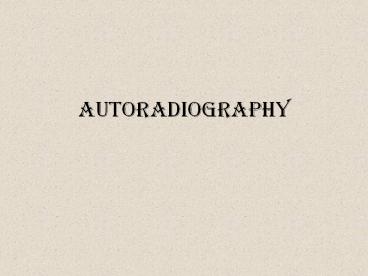Autoradiography - PowerPoint PPT Presentation
Title:
Autoradiography
Description:
Its a simple and effective ppt on autoradiography – PowerPoint PPT presentation
Number of Views:8064
Title: Autoradiography
1
AUTORADIOGRAPHY
2
Radioisotopes
- Isotopes(which have same chemical but different
physical properties) having radioactivity. - Natural occurrence is rare because of its
instability. - They emit different radiations such as a,ß and ?.
3
Detection of disintegration
- Electrical
- Eg GM counter, Ionisation
counter, Gas flow counter - Scintillation
- Eg scintillation counter
- Autoradiography
4
What is autoradiography?
5
Principle
Radiation will hit silver grains in emulsion and
expose them
Expose to film or emulsion
Isotope will emit radiation (usually beta)
Incubate tissue with radioactive ligand
6
HISTORY
- 1867 Uranium salts responsible for blackening
- of photographic film(Niepce de
st.victor) - 1896 K2UO2(SO4)2emits radiation affecting a
- photographic film(Becquerel)
- 1924 First autoradiogram distribution of Po
in - biological material
- 1943 Autoradiographic demonstration of 131I
in - tissue sections of thyroid
- 1946 Liquid photographic emulsion for
- autoradiography(Belanger and
LeBlond) - 1950 Stripping film technique for
microscopic - autoradiography
- 1970 Numerous biological applications
- 1990 Alternatives to film Imaging plate
technology
7
PROCEDURE
8
- Types
- In-vivo autoradiography
- In-vitro autoradiography
9
Cont
MICROSCOPIC AUTORADIOGRAPHY
Hypophysis of rat labelled with 3H
10
Macroscopic autoradiography
Localization on chromatogram or gel
Whale body autoradiography
11
RADIONUCLIDES USED
Radionuclide Radiation Type of energies
125I eAU, eIC X,? 3-35Kev 3-35Kev
3H ß 18.5Kev
35S ß 167Kev
12
- Localization
- Electron microscopical
- (cell and organelle level)
Thyroid of mouse after injection of 125I
13
Light microsopical (cell and tissue level)
Hypophysis of rat labelled with 3H
14
Macroscopical
Autoradiogram of a section through the head of a
monkey after intravenous injection af
35S-chlorpromazine.
15
Quantification
- Grain counting
- Track counting
- Densitomety
16
development
- X-ray film
17
IP Scanner
18
Imaging plate
19
PHOTOGRAPHIC DETECTION SYSTEMS
- Stripping film
- Eg. Kodak AR10
- Liquid photographic emulsion
- Eg. Kodak NB2
20
The Photographic Process
1
2
3
21
Special Types Of Autoradiography
- Fluorography
FILM
RADIOACTIVE OBIECT
ß-PARTICLE
LIGHT
22
Autoradiography/fluorography and chromatography
Traditional autoradiography with X-ray
film ß-particles act directly on the film
Enhanced autoradiography chromatogram treated
with vax-based scintillator ß-particles absorbed
in the object energy converted into light,
object transparent
Fluorography chromatogram treated with PPO
ß-particles absorbed in the object energy
converted into light
23
- Chemiluminescence
24
- Advantages
- Highly specific tool to pharmacologically
characterize receptors in tissue - Provides location of receptor in tissue
- Enables characterization of receptors in
different tissues between different animals or
brain regions - Technically easy
25
Disadvantages
- Everything binds to everything (easy to
misinterpret results) - There are no biochemical or physiological
criteria to - assess the binding specificity (i.e., to
determine whether the binding site really
corresponds to an actual receptor) - The presence of a high-affinity radiolabelled
receptor does not necessarily imply that the
receptor has physiological significance - Ligands are not always very specific
26
Autoradiographic investigation of protein
synthesis an example
Model based on pulse-chase experiments and
EM-autoradiography
Eucaryote cells in culture are subjected to a
pulse of radioactive amino acids, followed by a
surplus of unlabelled amino acid (chase). Cells
are drawn from the culture at different times
after the pulse, they are fixed and dyed for
electron micro-scopy, and exposed to
autoradiographic emulsion. After development and
fixation of the emulsion, the material is
investigated in the electron microscope. It is
possible to observe the cell organelles and the
location of radioactive material simultaneously.
The latter changes with time after the pulse.
27
Autoradiographic investigation of cell kinetics
an example
- Eucaryote cells (in vivo or in vitro) are
subjected to a pulse of 3H-thymidine, which is
incorporated in DNA in the cells that are in
S-phase during the pulse. The proportion of
labelled cells in the population may be used for
deriving parameters of cell kinetics (e.g. the
duration of the cell cycle). - In a variant of the technique, the cells
are first labelled with 3H-thymidine, and
subsequently after a known time interval ?t
with 14C-thymidine. Due to the different range
of the ß-radiation from 3H and 14C it is possible
to distinguish between cells labelled with 3H,
14C, or with both 3H or14C. The method provides
information on additional cell kinetic
parameters, e.g. the duration of the S-period.
28
Autoradiographic mapping of CNSan example
binding af 3HHC3 in rat brain
- Localization of
- Receptors
- Transporters
- Etc.
- Autoradiographical localization of receptors and
other specific sites in peripheral tissues or
in the CNS advantages as compared to biochemical
methods - More accurate anatomical localization (at the
neuron-level) - High sensitivity (103104 higher than for
biochemical assays)
29
- Other Uses
- Map anatomical location of radiolabelled ligands
to visualize and quantify receptors in tissue - Trace neurons by axonal transport of
radioactively labelled amino acids, certain
sugars, or transmitter substances - Measure DNA production (e.g., 3H-thymidine)
- Study of DNA viruses
- Ingestion Radioactive isotopes are also used to
track the distribution and retention of ingested
materials. Exotic radioisotopes with very short
half-lives are used clinically
30
CONCLUSION
Autoradiography can help to
establish the presence of radioactive elements in
various ores, radioactive material in tissues of
organisms. Makes it possible to gather accurate
data describing in which cell processes takes
place . Various substances are localized in the
tissue using this technique. This method also
helps in in establishing time parameters for
various process.
31
THANK YOU

